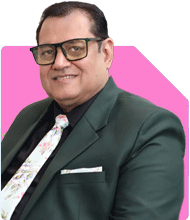Dr Ashish Sehgal | Answer |Ask -Follow
Relationships Expert, Mind Coach - Answered on Apr 18, 2023
I am 41 years old and married. My sexual desires are high and generally I need variety in terms of partners. Till now I had a relationship with almost 5 partners outside marriage. When it comes to my wife our sex life is ok. I love her very much. However, sometimes I do not get excitememt while having relation with wife. How I can work on this?
One way to work on this is to explore different sexual experiences with your wife. You can try new things together, such as different positions or incorporating toys, fantasies, or role-playing. You can also make an effort to create a more romantic and intimate atmosphere in your relationship, which can help increase excitement and pleasure during sex.
It's also important to address any underlying issues that may be affecting your desire for your wife. Stress, anxiety, depression, and health problems can all impact sexual desire. Talking to a therapist or a medical professional can help you identify and address any underlying issues.
Ultimately, it's important to remember that sexual desire fluctuates over time, and it's normal to experience highs and lows. With open communication and a willingness to try new things, you can work together to create a fulfilling and satisfying sexual relationship with your wife.
You may like to see similar questions and answers below
Anu Krishna |1746 Answers |Ask -Follow
Relationships Expert, Mind Coach - Answered on Aug 21, 2023
Anu Krishna |1746 Answers |Ask -Follow
Relationships Expert, Mind Coach - Answered on Aug 28, 2023
Anu Krishna |1746 Answers |Ask -Follow
Relationships Expert, Mind Coach - Answered on Feb 24, 2024
Dr Dipankar Dutta |1839 Answers |Ask -Follow
Tech Careers and Skill Development Expert - Answered on Dec 13, 2025
Dr Dipankar Dutta |1839 Answers |Ask -Follow
Tech Careers and Skill Development Expert - Answered on Dec 13, 2025
Mayank Chandel |2575 Answers |Ask -Follow
IIT-JEE, NEET-UG, SAT, CLAT, CA, CS Exam Expert - Answered on Dec 13, 2025
Radheshyam Zanwar |6742 Answers |Ask -Follow
MHT-CET, IIT-JEE, NEET-UG Expert - Answered on Dec 13, 2025
Mayank Chandel |2575 Answers |Ask -Follow
IIT-JEE, NEET-UG, SAT, CLAT, CA, CS Exam Expert - Answered on Dec 13, 2025
Mayank Chandel |2575 Answers |Ask -Follow
IIT-JEE, NEET-UG, SAT, CLAT, CA, CS Exam Expert - Answered on Dec 13, 2025
Kanchan Rai |646 Answers |Ask -Follow
Relationships Expert, Mind Coach - Answered on Dec 12, 2025
Ravi Mittal |677 Answers |Ask -Follow
Dating, Relationships Expert - Answered on Dec 12, 2025
Ramalingam Kalirajan |10881 Answers |Ask -Follow
Mutual Funds, Financial Planning Expert - Answered on Dec 12, 2025
Ramalingam Kalirajan |10881 Answers |Ask -Follow
Mutual Funds, Financial Planning Expert - Answered on Dec 12, 2025



























